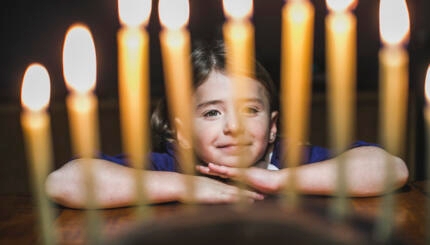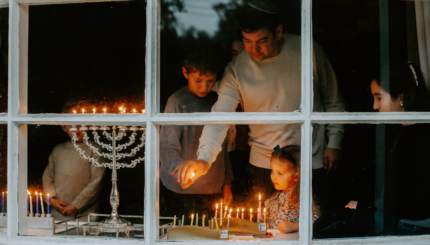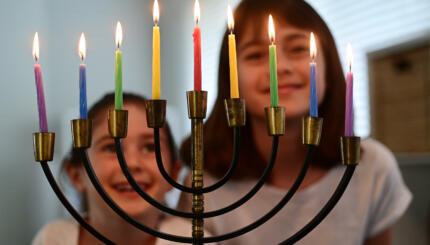The Maccabees were fighters. The early Maccabean leaders rose in revolt against the Seleucid tyranny and its Jewish collaborators who were turning Jerusalem into a Greek city, but the later leaders were no less power-seeking and corrupt than those whom their elders had made their reputation by defeating. For this and other reasons, they were little loved by the Rabbis, who accorded their victories hardly any space in the vast literature of the Talmud.
But there remain several achievements to their credit. They had the vision to fight an impossible war and the courage to win. Once they had regained the Temple precincts, they had the persistence to search them until they found a vessel marked with the High Priest’s seal. Then, although the oil they found was really far too little, they filled the lamps on the Menorah and set them alight, trusting in whatever would be. These acts represent the essential stages of leadership and inspiration.
1. Looking Past the Ruins
The Temple was defiled; Jerusalem, ruled by renegades, was in the grip of a foreign and antagonistic culture. But what the Maccabees saw was not defeat; they beheld the Temple as it would be–rebuilt. Look at the world in any age, in any place, and one has the same choice. One can either see only destruction and misery, the unending testimony of disappointment. Or one can see, together with and in defiance of it, striving, courage, and compassion, an ineradicable humanity in the humbling struggle to transform defeat into new hope.
One can see only the ruins of the Temple, or one can see the rebuilding as well.

Help us keep Jewish knowledge accessible to millions of people around the world.
Your donation to My Jewish Learning fuels endless journeys of Jewish discovery. With your help, My Jewish Learning can continue to provide nonstop opportunities for learning, connection and growth.
My friend, who works with victims of torture and persecution, shared with me a moving example of just this endeavor. An old peasant and a young man whose family had been killed for their political beliefs met in prison. One day the elderly man was brutally beaten. The young man comforted him, telling him that he would teach him to read, an opportunity his harsh fortunes had until then denied him. This, he said, would be the victory. By reading together they would make an affirmation of their common humanity. No amount of force could ever take that away.
It must have been a similar faith which led Anne Frank to write in her diary in July 1944:
“It’s really a wonder that I haven’t dropped all my ideals because they seem so absurd and impossible to carry out. Yet, I keep them, because in spite of everything, I still believe that people are really good at heart…. I see the world gradually being turned into a wilderness, I hear the ever-approaching thunder, which will destroy us too, I can feel the sufferings of millions and yet, if I look up into the heavens I think it will all come right, that this cruelty too will end, and that peace and tranquility will return again.”
2. Seeing the Sacred Everywhere
Every moment of life presents us with a choice in how we perceive; do we see disappointment and defeat or opportunity and hope? I am filled with wonder by what people have managed to achieve. In situations of conflict it is often women who lead the way back to the appreciation that the enemy are people, too. Modern communications have enabled mothers to cross battle zones and find mothers on the other side who have also lost a husband or child. The common humanity they discover transcends the power of war.
There are teachers who work with sick or maltreated children because they believe that the power of love will awaken the inborn creativity that lies within us all. There are caregivers who work with the dying because they trust that beyond pain and degradation lie acceptance and reconciliation. None of these people see only ruins; what they perceive is the human image, God’s temple, restored.
Behind this lies an earlier question: What is it that gives us the capacity to look at the world in this way? Where is the oil that burns with the light that enables us to see the sacred everywhere? For, as the Sefat Emet [Rabbi Yehudah Leib Alter of Ger, 1847-1905, a sage] taught, “There is such a very small point in every person which even now belongs to God.”
There is a vessel within each of us, the contents of which are simply not susceptible to contamination, a part of us which remains eternally pure. It is there that we must go to seek the oil that burns with a pure and sacred flame. The difficulty is to find it. That is the inner meaning of the Maccabees’ search among the ruins of the Temple for the one jar that was still intact, sealed with the High Priest’s seal.
3. Purity Within
The Talmud, in recounting the brief story of how the Maccabees found and lit the oil, suggests that there were other jars. But they were not pure; the High Priest’s seal was broken. In the same way, our lives contain many things that burn.
Anger burns. Of course, righteous anger sometimes leads us to stand up against wrong, but even justified anger often simply consumes its victim. I have sometimes had to say to people who are angry that they may indeed be right–they have been exceedingly badly treated–but who has become the main victim of their anger if not themselves? It will devour them, a second kind of suffering, but it won’t in the least affect the person who has wronged them.
Greed also burns; in our society its flames are constantly fueled. We are lured by countless incitements into the heat of our own desires. We do not see clearly by the light of such fires.
Like the Maccabees, we too must search the precincts of our inner self for what lies buried there. Then we may come to know by the testimony of our own heart that there is a part of us which nothing can contaminate. We have a certain purity of being that cannot be sullied. Light it, and it bums with a sacred radiance. Just as Midas’s touch turned everything to gold, so the spirit has the power to reveal the spirit in everything that lives.
But every day we have to struggle to find that flame; it is far more often lost than found. In silence, in beauty, in prayer, in the example of good people, we rediscover it and may be consoled by the reminder that, though hidden, it is never utterly or irretrievably lost.
4. Lighting the Flame
Once they had regained the Temple and found their jar of oil, there remained for the Maccabees one more issue: To light, or not to light? It cannot have been a simple decision. They knew, after all, that it would take eight days to replenish their supply and that the contents of the single flask they had would suffice for only one. Should they light it, or should they wait? Perhaps they should wait.
Till now, it had scarcely been their fault that the Menorah was extinguished; it was for this that they had fought. But if they were to light it now and then let it go out, wouldn’t they be responsible? After all, the flame, once burning, had to be tamid, constant.
The Maccabees lit the oil.
And light it one must. This is the essence of faith. We never know how long the flame that results from our deeds will last; but if the oil is pure, we must find the courage to use it. It is natural to think that we won’t have the energy to see our plans through, to worry that our courage may not last, that our confidence, our spirits, our love, or our faith may fail. These concerns are only human, but it would be wrong to let them prevent us from using what oil we have.
We must trust that what we begin in truth we, and others, will be given the strength to continue. If we first have to know how everything will end, we will never undertake anything, and our oil will go to waste.
Perhaps, it might be argued, the Maccabees were lucky. After all, God ordained a miracle and a single day’s supply of fuel burned for eight; but to think like that is, I believe, to misunderstand the nature of such wonders. For it is a wonder, but true, that such oil always burns more brightly and for longer than we think. Start something with real spirit, and though we may not have the energy to see it through, others will come to replenish the fire and restore the flame.
Thus one person’s vision becomes the inspiration of many. Or sometimes it is the spirit itself that nurtures us. Then our hope, courage, and energy are replenished night by night as if by some invisible pipette, and we enter our day restored by powers we ourselves do not understand.
For where, whatever our vision, whatever our searching, whatever our courage to light the light, did the first fire come from if not from the One who set the spirit within us and made all life sacred, if only we could see?
Reprinted with permission from The Eternal Journey: Meditations on the Jewish Year (Aviv Press).
Explore Hanukkah’s history, global traditions, food and more with My Jewish Learning’s “All About Hanukkah” email series. Sign up to take a journey through Hanukkah and go deeper into the Festival of Lights.



